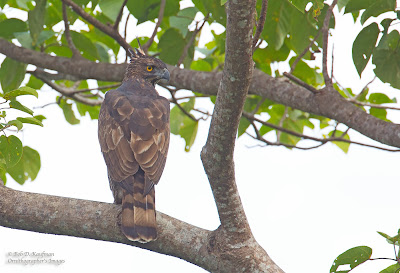Our second day at Subic turned out to be more about birders than birds.
A very early trip to Orica gate was a heartbreaker - hearing but not seeing the hoped for lifer, the White-fronted Tit. We also heard at least two kinds of owls. We could not even identify them! So we decided to take our chances at the Nabasan trail again. At the entrance we saw a foreigner with binoculars and a camera. "Birder!" my wife and I both exclaimed. We approached the guy and introduced ourselves. His name is Jens (pronounced "Yens") Hansen, a Danish guy who had been birding all over the world. Although young - probably in his late thirties - he is an "oldie" when it comes to birdwatching. We asked him to ride with us since we will be going to where he intends to go anyway.
Along the way we saw some Blue-throated Bee-eaters where there were Treeswifts yesterday. Just like yesterday, Nabasan trail turned out to be a complete dud. However, it was here that met Jorge and Tetch Garcia. Binoculars and camera was a give-away that these couple were also birders. When asked if they saw any birds, "A lot!" Jorge replied. We wanted to know what and he said, "Flycatcher!" and then showed us a photo of a Bee-eater. Obviously, they are still newbies, I thought. We suggested they try the area around Crownpeak Hotel and even offered to take them there. Along the way we stopped to look for the Green Imperial Pigeon. It was still there and this time it was joined by a Bar-bellied Cuckooshrike.
"Minivet!" Jens suddenly blurted.
"Where?"
"I don't know, I just heard it."
It was Cynthia who eventually found the Ashy Minivet peeping from a tree top.
At another stop we encountered first a single Grey-streaked Flycatcher. Eventually two more turned up to join their friend.
Finally we all got some very good looks at the Blue-naped Parrot, much to our new friends' delight.
Having shown Jorge and Tetch the birding place we described to them, my wife and I together with Jens returned to the Botanical Garden road. Nothing there. We need to return to our hotel before 10 am so we can avail of their free breakfast so we dropped off Jens to where we first saw him.
Another foray into Nabasan trail and Botanical Garden after breakfast yielded nothing but a White-throated Kingfisher.
We were about to give up birding Cubi Point, seeing only the Philippine Bulbuls and Large-billed Crows, when Cynthia heard the unmistakable screech of a Colasisi. Finally after much searching I saw it among the yellow flowers.
And then it was time to go. Our second day was not quite productive bird-wise but we did gain three birder friends. For my wife and myself that is still a plus.
Handsome Wood Duck Pair
4 days ago








































